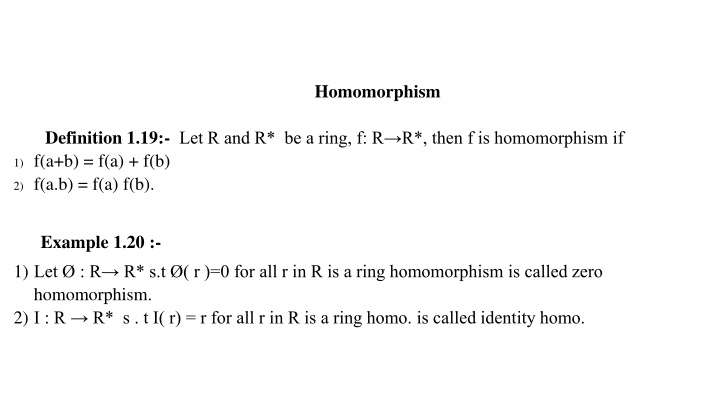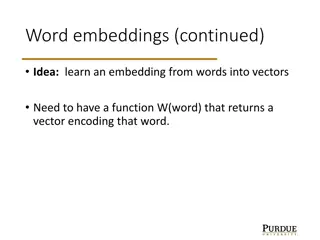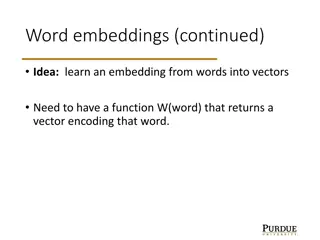Homomorphisms and Ring Embeddings
A detailed exploration of ring homomorphisms, zero and identity homomorphisms, and the concept of imbedding rings with identity. Learn about monomorphisms, epimorphisms, and isomorphisms in ring theory.
Download Presentation

Please find below an Image/Link to download the presentation.
The content on the website is provided AS IS for your information and personal use only. It may not be sold, licensed, or shared on other websites without obtaining consent from the author.If you encounter any issues during the download, it is possible that the publisher has removed the file from their server.
You are allowed to download the files provided on this website for personal or commercial use, subject to the condition that they are used lawfully. All files are the property of their respective owners.
The content on the website is provided AS IS for your information and personal use only. It may not be sold, licensed, or shared on other websites without obtaining consent from the author.
E N D
Presentation Transcript
Homomorphism Definition 1.19:- Let R and R* be a ring, f: R R*, then f is homomorphism if 1) f(a+b) = f(a) + f(b) 2) f(a.b) = f(a) f(b). Example 1.20 :- 1) Let : R R* s.t ( r )=0 for all r in R is a ring homomorphism is called zero homomorphism. 2) I : R R* s . t I( r) = r for all r in R is a ring homo. is called identity homo.
Definition 1. 21 :- Let f: R R*be a ring homomorphism. 1) If f is one to one, then f is monomorphism. 2) If f is onto, then f is epimorphism. 3) If f is (1 1) and onto, then f is isomorphism. Definition 1.22:- If f: R R* and f is isomorphism, then we say that R is isomorphic to R*, and R R* Remark 1.23:- If f: R R*be a ring homomorphism, then 1) f(0R) = 0R 2) f(-a) = -f(a) for all a in R. 3) F(1R) = 1R, when R and R* are rings with identity.
Theorem 1.24: - Any ring can be imbedded in a ring with identity. Proof: - Let R x Z = { (r , n ) : r R, n Z} Define + and. on R x Z as follows: ( r , n ) + ( t , m ) = ( r + t , n + m ) . ( r , n ) . ( t , m ) = ( rt + nt + mr, nm ) Then R x Z is a ring with identity ( 0 , 1) (r , n ) . ( 0 , 1 ) = ( r , n ) R x { 0 } R x Z. Now we must show that R x {0} is a sub ring of R x Z. (a , 0 ) { R x {0} - (b , 0 ) { R x {0} f = ( a b , 0 ) R x {0} (a , 0 ) . ( b , 0 ) = ( ab , 0 ) R x {0 }
Now we define a map : R R x {0}; (r ) = ( r , 0 ) for all r in R. 1) Let ( r1) = ( r2) ( r1 , 0 ) = ( r2 , 0 ) , implies that r1 = r2 is 1 1 1) Let (w , 0 ) R x {0} (w) = ( w , 0) is onto, is isomorphism. 1) ( r1 + r2 ) = ( r1+ r2, 0 ) = ( r1 , 0 ) + ( r2, 0 ) = (r1) + (r2). (r1r2) ( r1r2 , 0 ). (r1). (r2) = ( r1 , 0 ). ( r2 , 0) = ( r1r2, 0) is homomorphism. R R x {0} R is imbedded in a ring R x Z.























